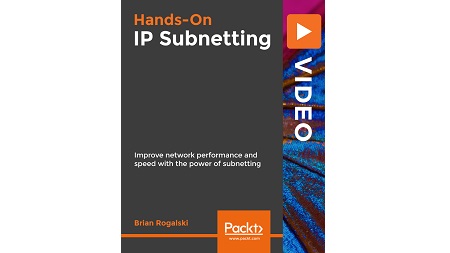
English | MP4 | AVC 1920×1080 | AAC 48KHz 2ch | 2h 45m | 289 MB
Carve networks like a pro!
Do you want to enhance your network efficiency and security? Do you have your entire network in one subnet? Current trends dictate that everything is on the internet, hence huge volumes of traffic are going through your network, causing slow running times and increased vulnerability to threats. Thus, subnetting has become a “must” to protect your network.
In this course, you will be presented with several modules that contain all you need to know about network subnetting. You will start with a review of numbering systems and LAN/WAN topics to reinforce prerequisite networking concepts and then deep-dive into IPV4 addressing and subnetting. You will learn how to extend your skills to subnet on the more recent IPv6 networks and you’ll gain a solid understanding of their advantages. You will also learn about classless and classful addressing systems and subnetting with a combination of lectures followed by labs to help you get hands-on.
By the end of the course, you will have gained a thorough knowledge of subnetting concepts and the confidence to create any number and type of subnets suiting your own network environment.
Please note: You should have a basic understanding of networking, computer numbering systems, and the OSI model before taking this course.
Learn
- Learn numbering systems and convert numbers to binary and hexadecimal for subnetting
- Understand the fundamentals of the IPv4 addressing system to form better subnets
- Get familiar with OSI, TCP/IP models, and IP protocols (FTP/DNS etc) to improve the performance of your network and provide flexibility
- Learn CIDR and Variable Length Subnetting to save resources used to maintain IP routing tables
- Subnet Class C, B, and A networks with full-length subnet masks to fully utilize your IP addresses
Table of Contents
Number Systems and Networking
1 The Course Overview
2 Introduction to Numbering Systems
3 Network Devices
4 Getting Familiar with the OSI and TCP IP Model
5 Numbering Lab
6 Quiz
IPv4 Addressing and Subnetting
7 IPv4 Addressing System
8 Classless Inter-Domain Routing (CIDR)
9 Subnetting Basics
10 Implementing Class C Subnetting
11 Variable Length Subnet Masking
12 Subnetting Practice Class C
13 IPv6 and Its Advantages over IPv4
14 Quiz
Subnetting Class and Practice
15 Subnetting Class C Networks
16 Solving Subnetting
17 Troubleshooting Subnetting
18 Subnetting Class A and B Networks
19 Subnetting Class A Networks
20 Subnetting Labs
21 Quiz
Additional Tips and Tricks
22 Exam Tips
23 Post Assessment Questions
24 Course Summary
Resolve the captcha to access the links!